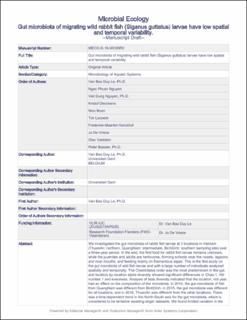| dc.description.abstract | We investigated the gut microbiota of rabbit fish larvae at three locations in Vietnam (ThuanAn—northern, QuangNam—intermediate, BinhDinh—southern sampling site) over a three-year period. In the wild, the first food for rabbit fish larvae remains unknown, while the juveniles and adults are herbivores, forming schools near the coasts, lagoons, and river mouths, and feeding mainly on filamentous algae. This is the first study on the gut microbiota of the wild fish larvae and with a large number of individuals analyzed spatially and temporally. The Clostridiales order was the most predominant in the gut, and location-by-location alpha diversity showed significant differences in Chao-1, Hill number 1, and evenness. Analysis of beta diversity indicated that the location, not year, had an effect on the composition of the microbiota. In 2014, the gut microbiota of fish from QuangNam was different from that in BinhDinh; in 2015, the gut microbiota was different for all locations; and, in 2016, the gut microbiota in ThuanAn was different from that in the other locations. There was a time-dependent trend in the north–south axis for the gut microbiota, which is considered to be tentative awaiting larger datasets. We found limited variation in the gut microbiota geographically and in time and strong indications for a core microbiome. Five and fifteen OTUs were found in 100 and 99% of the individuals, respectively. This suggests that at this life stage the gut microbiota is under strong selection due to a combination of fish–microbe and microbe–microbe interactions. | en_US |
